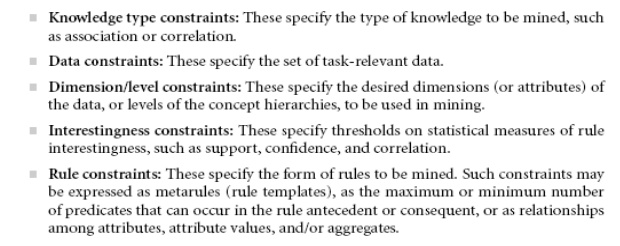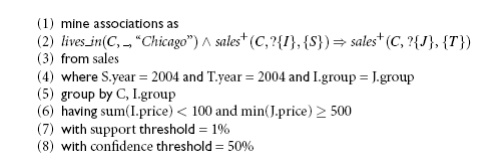Chapter: Data Warehousing and Data Mining : Association Rule Mining and Classification
Constraint-Based Association Mining
Constraint-Based
Association Mining
A data
mining process may uncover thousands of rules from a given set of data, most of
which end up being unrelated or uninteresting to the users. Often, users have a
good sense of which
―direction‖
of mining may lead to interesting patterns and the ―form‖ of the patterns or
rules they would like to find. Thus, a good heuristic is to have the users
specify such intuition or expectations as constraints
to confine the search space. This strategy is known as constraint-based mining.
The constraints can include the following:

1. Metarule-Guided Mining of Association Rules
“How are metarules useful?” Metarules
allow users to specify the syntactic form of rules that they are interested in mining. The rule forms can be used as
constraints to help improve the efficiency of the mining process. Metarules may
be based on the analyst’s experience, expectations, or intuition regarding the
data or may be automatically generated based on the database schema.
Metarule-guided mining:- Suppose
that as a market analyst for AllElectronics, you have access to the data describing customers (such as
customer age, address, and credit rating) as well as the list of customer
transactions. You are interested in finding associations between customer
traits and the items that customers buy. However, rather than finding all of the association rules reflecting
these relationships, you are particularly interested only in determining which
pairs of customer traits SCE Department of Information Technology promote the sale of office software.A
metarule can be used to specify this information describing the form of rules
you are interested in finding. An example of such a metarule is

where P1 and P2 are predicate variables that are instantiated to attributes from
the given database during the mining process, X is a variable representing a customer, and Y and W take on values of
the attributes assigned to P1 and P2, respectively. Typically, a user will
specify a list of attributes to be considered for instantiation with P1 and P2. Otherwise, a default set may be used.
2. Constraint Pushing: Mining Guided by Rule Constraints
Rule
constraints specify expected set/subset relationships of the variables in the
mined rules, constant initiation of variables, and aggregate functions. Users
typically employ their knowledge of the application or data to specify rule
constraints for the mining task. These rule constraints may be used together
with, or as an alternative to, metarule-guided mining. In this section, we
examine rule constraints as to how they can be used to make the mining process
more efficient. Let’s study an example where rule constraints are used to mine
hybrid-dimensional association rules.
Our
association mining query is to “Find the
sales of which cheap items (where the sum of the prices is less than $100) may
promote the sales of which expensive items (where the minimum price is $500) of the same group for Chicago customers
in 2004.” This can be expressed in the DMQL data mining query language as follows,

Related Topics